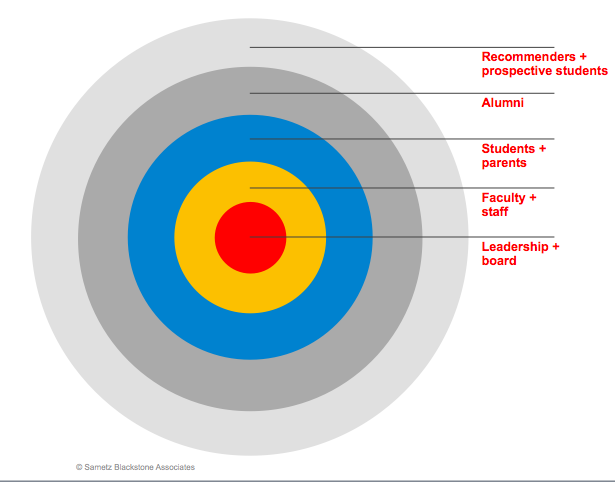You have /5 articles left.
Sign up for a free account or log in.
As Roger recently wrote for Call to Action, creating an authentic, resonant brand for your school or organization is a process — not an event. But any brand-building effort needs to start with research: it’s hard to drive meaningful change if you don’t know where your brand is right now, or where you’d like it to go.
So, how do you get these answers? Whether you choose to work with a professional consultant or conduct and analyze research yourself, the following details our approach to getting calibrated in order to move your brand forward — strategically, tactically, and successfully.
Qualitative Learning
Starting with those closest to the organization’s “center” (senior leadership and board members), set up qualitative interviews to examine key questions about the institution’s goals, vision, and challenges — both strategic and tactical. Where is the institution currently positioned in the competitive landscape and where does it need to be? What types of students are you attracting (and enrolling), what students make for a good fit, and where do students who don’t matriculate end up enrolling? What are the brand attributes currently associated with the institution, what attributes would leadership like to see associated, and what myths and outdated perceptions need to be actively dispelled?
Then, identify individuals and groups progressively farther out to interview. Ideally, these people will be representative of, and representatives to, their respective groups. You can’t meet with the entire faculty individually, but you can meet with influential members who have both the endorsement and respect of their peers. The same goes for staff, students, and alumni.

These conversations serve two important purposes: you will learn a lot about your institution that perhaps you didn’t know and you’ll get people across the campus engaged early in the brand-building process. Any “squeaky wheels” should also purposefully be a part of the process: inviting them in will go a long way toward diffusing resistance to change and will encourage them to be cheerleaders for your brand-building efforts.
The actual questions you ask will be different for different groups, of course. And as you move further from the center, you’ll be able to validate — or challenge — leadership’s assumptions. Do students believe that the institution is in fact delivering the value that leadership claims it does? Do alumni agree with the reasons leadership thinks they should stay engaged?
Quantitative Learning
In addition to qualitative interviews, quantitative surveying allows you to reach large numbers of people in a cost-efficient manner. It’s most useful when trying to get information from a statistically significant sample set of students or alumni toward the outer rings of the chart, above.
However, quantitative approaches are best employed to gauge where your brand is right now, or where it’s been — not where you want it to go. So if change is needed to realize your goals, qualitative research is where you should focus most of your time and resources.

Audits: Looking Inward and Outward
The final, complementary step of any brand investigation is an audit of the print, digital, and social communications your organization produces, as well as those of key competitors.
Gather all your communications. You (and any outside counsel) should thoughtfully, objectively evaluate these materials. Do they verbally and visually reflect the attributes you want to reinforce and those you aspire to have associated — or do they send different messages entirely? Do they match what you want important audiences to believe? Does your use of color, type, imagery, and design advance what you want to be known for?
Lastly, you will want to review the top-level communications of the institutions in your competitive set, as well as those you aspire to compete with. What are their value propositions and how do they prove them? What affect informs their materials? While you certainly don’t want to copy any of your competitors, you need to know what position they’ve staked out before you evolve yours.
Put It All Together
Through qualitative and quantitative surveying and an audit of your and your competitors’ communications, you will have learned a lot and gathered the information necessary to both clearly tell you where you are and allow you to realize opportunities ahead.
In the weeks to come, our colleagues at Sametz Blackstone Associates will share their tips on putting your research to work in the service of helping you to develop an organizational brand that is both verbally and visually compelling, across media.
Caity McLaughlin Lischick (caity@sametz.com) is Director, Strategic Engagement and Roger Sametz (roger@sametz.com) is president and CEO at Sametz Blackstone Associates, a Boston-based brand consultancy that integrates brand, editorial, and digital strategy with design and digital media.
This post is the second in a series of eight by senior staff at Sametz Blackstone Associates to help you craft an authentic, differentiating verbal and visual brand — to build interest, comprehension, enrollment, and support.




